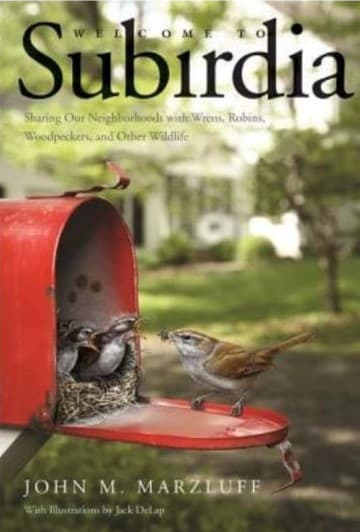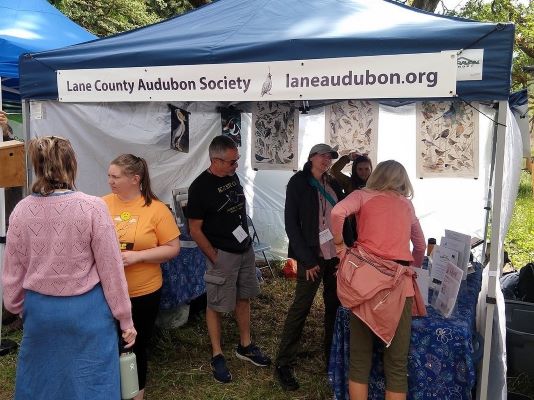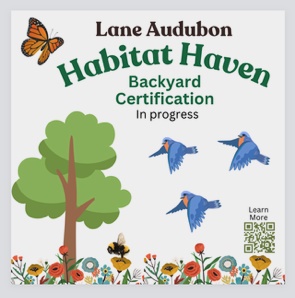Welcome to Jan Rising, who is our new Board Recording Secretary! Jan moved to Eugene…

I recently revisited my John Marzluff book, Welcome to Subirdia, published in 2014. Lane Audubon has enjoyed Marzluff’s program presentations in person and via Zoom. Marzluff is a Professor of Wildlife Science at the University of Washington, plus author of In the Company of Crows and Ravens, and several other books. Subirdia is an informative read, as it provides a summary of his multi-year research projects along with research results from other scientists studying birds that live at the interface of human and non-human population areas. He also presents examples of evolutionary changes in some birds, as a result of their close association with human impacts, such as noise, light, harassment, and chemical pollution within and near urban areas. Through his studies, he documents many negative impacts that human lifestyles inflict on bird populations.
In the next to last chapter, “Good Neighbors,” Marzluff asks his readers to consider practicing the following principles:
- Do not covet your neighbor’s lawn. Lawns are really ecological disasters of the highest magnitude.
- Keep your cat indoors!
- Make your windows visible to birds.
- Do not light up the night sky.
- Provide food, water, nest boxes, and other provisions that birds need.
- Do not kill native predators.
- Foster a diversity of habitats within the cities where we live.
- Create safe passages across roads and highways.
- Work with planning authorities to ensure the existence of functional connections which allow animals to move safely and easily between aquatic and terrestrial habitats in our urban and rural areas.
- 1 Enjoy and bond with nature where you live, work, and play.
Engaging with nature allows people to appreciate nature, build respect for it, care, wonder, and even love nature.
Simply put…Love thy wild neighbor!
Marzluff’s words ring true, now that the timber companies have successfully used fear of fire to gain unlimited logging rights throughout our western states. These decisions were made with no mention of habitat, wildlife, or carbon sequestration. There is no mention of how big stands of trees cool the earth with shade, store water in their shade, and absorb carbon dioxide as they “breathe.” Allowing the timber companies to profit from these fear tactics and ignore the basic biology of our interconnectedness with the environment is a huge and destructive oversight. Every living being on the planet requires a healthy environment to survive. By removing all forest trees and understory plants, we undermine our very existence and push ourselves, and every other living thing on the earth, closer to a withered and hopeless future. We can do better than this!
Read on…
Below are a few more books at the top of my reading list—books that can help increase our understanding of the dynamics of our shared environment.
Finding the Mother Tree: Discovering the Wisdom of the Forest Book, by Suzanne Simard, suzannesimard
.com/ (May 4, 2021)
Suzanne Simard is a Professor of Forest Ecology at the University of British Columbia. She is a pioneer on the frontier of plant communication and intelligence, and has been hailed as a scientist who conveys complex, technical ideas in a way that is dazzling and profound. Her work has influenced filmmakers (The Tree of Souls in James Cameron’s Avatar), and her TED talks have been viewed by more than 10 million people worldwide. In her first book, Simard brings us into her world, the intimate world of the trees, in which she brilliantly illuminates the fascinating and vital truths – that trees are not simply the source of timber or pulp, but are a complex, interdependent circle of life; that forests are social, cooperative creatures connected through underground networks by which trees communicate their vitality and vulnerabilities with communal lives not that different from our own.
Simard writes how trees, living side by side for hundreds of years, have evolved; how they perceive one another, learn and adapt their behaviors, recognize neighbors, and remember the past; how they have agency about the future; elicit warnings and mount defenses; compete and cooperate with one another with sophistication, exhibiting characteristics ascribed to human intelligence, traits that are the essence of civil societies. And at the center of it all, the Mother Trees: the mysterious, powerful forces that connect and sustain the others that surround them.
Author Douglas W. Tallamy has several books that educate and engage readers to do their part in helping our planet earth. Doug Tallamy is a professor in the Department of Entomology and Wildlife Ecology at the University of Delaware, where he has taught insect-related courses for 40 years. His book with Timber Press,“Nature’s Best Hope: A New Approach to Conservation That Starts in Your Yard (February 04, 2020), is a New York Times Best Seller.
The Nature of Oaks: The Rich Ecology of Our Most Essential Native Trees (March 30, 2021)
The Living Landscape: Designing for Beauty and Biodiversity in the Home Garden (July 01, 2014)
Bringing Nature Home: How You Can Sustain Wildlife with Native Plants, Updated and Expanded (April 01, 2009)
A World on the Wing—The Global Odyssey of Migratory Birds Release date March 2022 by Scott Weidensaul, scottweidensaul.com/
“Scott Weidensaul’s gripping journey alongside the world’s feathered wanderers and the people who study them. …Littered with such wonders…[it] rivals the astonishing feats of the birds he chronicles. … As the birds flit through these pages, but with ever less frequency through our lives, we can only hope that birders and non-birders alike take inspiration and a call to action from A World on the Wing. This is the kind of book we’ve been waiting for.” — Christian Cooper, The New York Times



